eOrganic author:
Dr. Mary E. Barbercheck, Penn State University
Summary
This article provides general information on the biology and life cycles, damage from and management of the aphid pests in organic cucurbit crops. Specific information is provided for the most common aphid pests in cucurbits: the green peach aphid (Myzus persicae), melon aphid (Aphis gossypii), the potato aphid (Macrosiphum euphorbiae), and the bean aphid (Aphis fabae).
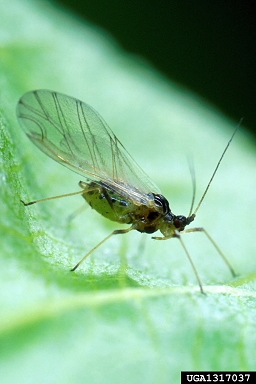
Figure 1. Green peach aphid, Myzus persicae (Sulzer). Figure credit: Scott Bauer, USDA Agricultural Research Service, Bugwood.org.
General Information
Aphids (Fig. 1) are small (about 1/8th inch long), soft-bodied, pear-shaped insects with long legs and antennae, commonly found on cultivated plants. Sometimes called plant lice or green bugs, aphids use their long, slender mouthparts to pierce and suck plant fluids from stems, leaves, and other tender plant parts. Aphids can be green, yellow, brown, red, or black. Some secrete a waxy white or gray material that covers their body, giving them a waxy or wooly appearance. Most species have a pair of tube-like structures called cornicles projecting rear-wards from their abdomen. Cornicles distinguish aphids from all other insects.
Adult aphids are usually wingless, but most species also occur in winged forms, especially when populations are high or during spring and fall. Wings allow aphids to disperse to other plants when the quality of the food source deteriorates. Aphids can disperse great distances when carried by wind.
Aphid Biology and Life Cycles
Aphids can produce several generations per year. Most aphid species reproduce asexually (without mating), with adult females giving birth to live immature aphids called nymphs. Nymphs are always wingless. The nymphs molt, shedding their skin multiple times before becoming adults. Aphids can have simple or complex life histories. Some aphid species use only a single species of host plant to complete their life cycle, whereas other species require two species of host plants. Some aphid species mate and produce eggs, which in some cases are laid on an alternate host, usually a perennial plant species.
When conditions are favorable, many species of aphids can develop from nymph to reproducing adult in about one week. Because each adult aphid can produce numerous nymphs in a short period of time, aphid populations can rapidly increase.
Aphids usually feed in dense groups on leaves or stems, although they can sometimes be found singly. Aphid infestations usually start when small numbers of winged aphids fly to or are blown into a field of suitable host plants. They deposit several nymphs on tender plant tissues before flying to a new plant. The nymphs feed on plant sap, molt and increase in size. They mature in 7–10 days and then are capable of producing live young. Aphid numbers build until crowding or plant stress stimulates the production of winged forms. The winged forms fly from the plant to search for new hosts, where the process is repeated.
Damage from many species of aphids is greatest when temperatures are relatively cool (65–80 °F). Aphids tend to first occur along the upwind edge of a field and close to other sources of aphids, so these areas should be monitored closely. Many aphid species prefer the undersides of leaves; be sure to turn leaves over when monitoring.
Damage Caused by Aphids in Cucurbits
Damage from aphids can be direct or indirect. Direct damage to plants occurs from the feeding activity of aphid nymphs and adults. Aphids pierce the plant tissue and extract sap, which results in a variety of symptoms, including decreased growth rates and reduced vigor; mottling, yellowing, browning, or curling of leaves; and wilting, low yields, and plant death. Saliva injected into plants by aphids can cause leaves to pucker, curl, or become distorted. Curled and distorted leaves can protect aphids from natural enemies or applied treatment materials. Aphids feeding on flower buds and fruit can cause malformed flowers or fruit.
Indirect damage can be caused by deposits of honeydew. Honeydew is the sticky, sugary liquid waste produced by aphids as a result of feeding on plant sap. Honeydew can attract other insects, such as ants, that will feed on the honeydew. Ants can aggressively defend aphids (and their honeydew food source) from predators and parasites, and interfere with the control of aphids by natural enemies. Honeydew deposits that accumulate on the plant can also create a growth substrate for sooty molds (Fig. 2). Sooty molds are dark fungi comprised of a complex of several fungal species. Sooty mold growth on leaves and other plant parts blocks light and can reduce photosynthesis.
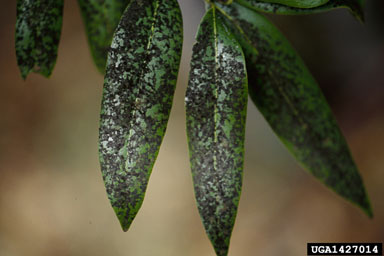
Figure 2. Sooty mold. Figure credit: Joseph O'Brien, USDA Forest Service, Bugwood.org.
Indirect damage is also caused by the ability of some aphid species to serve as virus vectors. Aphids alone generally do not cause major economic losses in cucurbit crops. However, the viruses transmitted by aphids can cause severe losses. Several mosaic diseases are caused by aphid-transmitted viruses, including cucumber mosaic virus (CMV), watermelon mosaic virus (WMV), zucchini yellow mosaic virus (ZYMV), and papaya ringspot virus (PRSV). Virus diseases often have distinctive symptoms and result in reduced growth and yield. The symptoms of virus infection include mottling, yellowing or curling of leaves, and stunting of plant growth. Under favorable conditions, these viruses can cause a high rate of crop failure and severe economic losses.
Transmission of viruses by aphids is generally of two types: non-persistent and persistent. Aphids acquire non-persistently transmitted viruses after just a few seconds of feeding or probing virus-infected plant tissues with their mouthparts, and can transmit virus to another plant immediately. However, the persistence of the virus in the aphid is very short-lived—only a few minutes. Acquisition of persistently-transmitted viruses requires 10–60 minutes of feeding and, following a 12-hour incubation period, aphids will remain infective for up to their entire life span. In most cases, the green peach aphid and the melon aphid acquire virus by probing or feeding on weeds or other cucurbit crops that are infected. The insects then probe or feed on non-infected crops and transmit the virus. The higher the aphid population, the more rapid the virus spread.
Management of Aphids in Organic Cucurbits
The pest management goal in organic production systems is to design the system so that pests do not find plants, are controlled by natural enemies (biological control), or their damage is kept to a minimum. Vigorous, healthy plants are more able to withstand damage caused by arthropods and disease. Therefore, a “plant positive” (as opposed to “pest negative”) approach to managing the system for beneficial processes and cycles and creating healthy soil and plants, is the foundation of integrated pest management in organic systems.
Cultural Control of Aphids in Cucurbits
A crop rotation plan to proactively manage pests is the foundation of organic crop production. Rotating between crop families can help minimize crop-specific insect pests. Late-season fields should be planted as far away from existing cucurbits as possible. Later plantings and long-season cucurbits are generally most affected by aphid-transmitted mosaic viruses because aphid populations are higher and virus-infected host plants are more available, resulting in more aphids carrying virus. Weeds such as burdock, pokeweed, and other perennial broadleaf weeds can serve as reservoirs for Cucumber Mosaic Virus and Watermelon Mosaic Virus, and should be eliminated.
Plants should be grown with appropriate soil fertility levels. Excessive nitrogen favors aphid reproduction. Application of less soluble forms of nitrogen, in small portions throughout the season rather than all at once, is less likely to promote aphid infestations.
Plants should be inspected for signs and symptoms of an aphid infestation. Special attention should be given to susceptible plant parts where aphids are most likely to establish, such as the undersides of leaves, stems, and buds or tip growth. Also look for honeydew, sooty mold, leaf yellowing, distortion of leaves and new growth, and cast skins produced by molting nymphs. Locations in the field or greenhouse where aphids are found should be flagged, so that population development can be monitored and management efforts evaluated.
Planting non-GMO resistant varieties is one of the primary means of controlling aphid-transmitted viruses. The availability of cucurbit varieties with virus resistance varies depends on the specific virus and cucurbit. Information on resistant cucurbit varieties can be found in Cooperative Extension publications and in catalogs of major seed producers. The source of resistance in some virus-resistant cucurbits is transgenic. Genetically-modified, transgenic varieties are not allowed in organic production systems. Therefore, it is important to verify that the resistant variety being considered is not transgenic.
Physical Control of Aphids in Cucurbits
Many vegetables are most susceptible to aphid damage during the seedling stage. Older plants are more tolerant of aphid feeding. Losses can be reduced by growing seedlings in a greenhouse or under protective covers, such as floating row cover. Protective covers will also prevent transmission of aphid-transmitted viruses. Check transplants for aphids and remove them before planting or destroy infested plants by dropping the plant or infested plant part in a bucket of soapy water, and dispose of them away from the field. To prevent rapid spread of the aphid population in the field, remove and bury, if possi, the few severely infested plants as they appear in spring.
Floating row covers or reflective mulches may help exclude or repel aphids. Aluminum foil mulches can repel invading aphid populations, reducing numbers on seedlings and small plants, and can reduce transmission of aphid-transmitted viruses in summer squashes, melons, and other susceptible vegetables. However, as plants grow, aluminum foil mulches appear to also repel natural enemies of aphids. Because temperatures are higher above foil-mulched plants than above bare soil, aphids that do establish on plants can grow and reproduce at a faster rate. Even so, yields of vegetables grown on aluminum foil mulches are usually higher than those grown on bare soil because of the greater amount of solar energy reflecting on leaves. In very hot or arid areas, reflective mulches can cause conditions that are too warm for good crop growth, and are not recommended.
In small plantings, aphid populations on sturdy plants can be reduced with a strong spray of water. Most aphids dislodged in this way will not return to the plant. Using water sprays should occur early in the day to allow plants to dry to reduce the likelihood of fungal disease of cucurbits. Frequent rain will reduce the number and duration of aphid flights. Heavy rains can also dislodge aphids. Humid conditions favor the development of fungal disease in aphid populations.
Biological Control of Aphids on Cucurbits
Biological control by natural enemies (predators, parasitoids, and pathogens) can have a significant impact on aphid populations. Natural enemies can be conserved through refraining from using broad-spectrum pesticides that kill both pest and beneficial insects. Natural enemy populations can be conserved by creating habitats that provide resources (farmscaping). Farmscaping methods include the use of insectary plants, hedgerows, cover crops, and water reservoirs to attract and support populations of beneficial organisms such as insects, spiders, amphibians, reptiles, bats, and birds that parasitize or prey upon insect pests. Keeping dust down also encourages parasitism and predation.
Beneficial insects will be attracted to plants with moderate to heavy aphid infestations. These natural enemies may eat large numbers of aphids but the reproductive capability of aphids may be so great that the impact of the natural enemies will not be enough to keep the aphids at or below acceptable levels. Even if aphid populations are reduced to an acceptable level, if virus is present, it may be spread by the few remaining aphids.
Predators catch and eat their prey. Some common aphid predators include:
- Many species of lady beetles and their larvae (e.g., the multicolored Asian lady beetle, Harmonia axyridis; the convergent lady beetle, Hippodamia convergens; the pink spotted lady beetle, Coleomegilla maculata
- Minute pirate bug, Orius insidiosus and O. tristicolor
- Larvae of the syrphid fly (hover fly or flower fly)
- Green Chrysoperla carnea, C. rufilabris, Chrysopa spp.) and Brown (Hemerobius spp.) lacewing larvae
- Larvae of the aphid midge (Aphidoletes aphidimyza)
Parasitoids (sometimes called parasites) do not usually eat their hosts directly. Adult parasitoids lay their eggs in, on, or near their host insect. When the eggs hatch, the immature parasitoids use the host as food, ultimately killing the host. The parasitized aphid forms a mummy that appears bloated and tan, light brown, or white (Fig. 3). When the weather is warm, the generation time of most parasitoids is quite short. The aphid population is likely to be reduced substantially within a week or two of seeing mummies on plants.
Some common aphid parasitoids (Fig. 4) (parasitic wasps) include:
- Aphidius colemani, A. matricariae
- Lysiphlebus species
- Aphelinus species
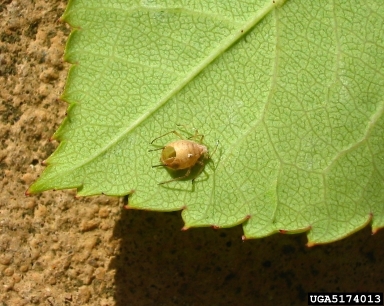
Figure 3. Aphid mummy. Figure credit: Nick Dimmock, University of Northampton, Bugwood.org.
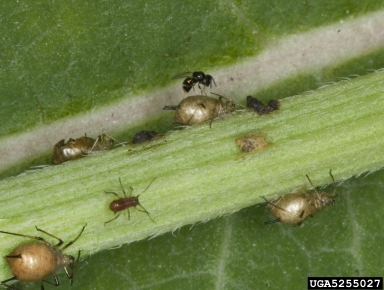
Figure 4. Aphid parasitic wasp (parasitoid) and aphid mummies. Figure credit: David Cappaert, Michigan State University, Bugwood.org.
Fungal Diseases of Aphids
Aphids are very susceptible to fungal diseases in humid weather. Fungi that infect insects are found in the environment as spores. Insects can become infected when they come into contact with spores on the surface of plants, in the soil, in the air as windborne particles, or on the bodies of already dead insects. Spores attach to the surface of the insect and infect by penetrating through the insect cuticle. Once inside, the fungus grows throughout the body of the insect, killing the insect in the process. Fungus-infected aphids appear reddish or brown and have a fuzzy, shriveled texture. Some fungi that infect and provide biological control of aphids, including Beauveria bassiana, Metarhizium anisopliae, Verticillium lecanii, and Neozygites fresenii, can provide good biological control of aphids.
Fungal diseases, when they occur, can be more effective than insecticides for controlling large populations of aphids. Fungal spores require high humidity to germinate, and hot, dry weather can inhibit the establishment of fungal disease in an aphid population. However, once established, fungal disease spreads rapidly, creating an epidemic. When an aphid population collapses from a fungal epidemic, populations tend to remain low for the rest of the season. Fungicides used to control plant pathogenic fungi will probably also kill any beneficial fungi present.
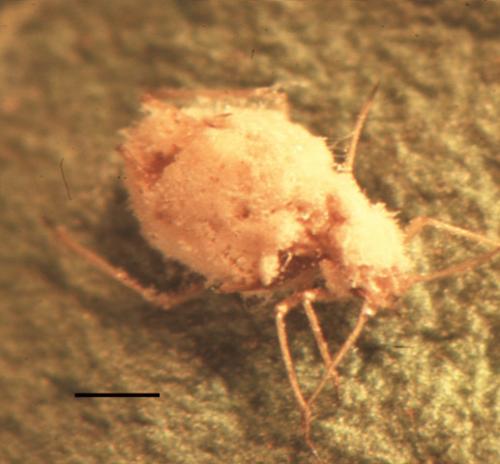
Figure 5. Green peach aphid, Myzus persicae, infected by the fungus, Pandora neoaphidis. Figure credit: Sergio Sanchez, Wikimedia Commons.
Chemical Control of Aphids in Cucurbits
Products should not be relied upon as a primary method of insect control. Scouting is important for detecting infestations at an early stage. When conditions warrant an application, proper choice of materials, proper timing, and excellent spray coverage are essential (Seaman et al., 2009). Only when all non-chemical practices are insufficient to prevent or control crop pests, may a biological or botanical material allowed for use on organic farms be used. Before applying any pest control product, make sure to include what you might want to use and how you intend to use it in your organic system plan and get your certifier's approval. (Caution: the use of an unapproved material can result in the loss of certification. Always check with your certifier before purchasing or using a new product or material to ensure that it is permitted for use in your organic farming system. For more information, read the related article, Can I Use This Input On My Organic Farm?).
Application of broad-spectrum foliar insecticides will also kill beneficial insects, and allow aphid populations to rebound. This is because most aphids are females that don't need to mate to produce new aphids. The reproduction of natural enemies is slower, often requiring time for mating, egg-laying, and egg hatch.
Insecticidal soaps, azadirachtin, and certain oils are acceptable for use in organically grown crops. Rosemary oil is less disruptive of beneficials than soaps and narrow range oils. They require direct contact with the insects and leave no residual effect.
Major Aphid Pests in Organic Cucurbits
The most common aphid species affecting cucurbits have a large host range and are pests of several horticultural and agronomic crops. These aphids include the green peach aphid (Myzus persicae), the melon aphid (Aphis gossypii), the potato aphid (Macrosiphum euphorbiae), and the bean aphid (Aphis fabae).
The Green Peach Aphid (Myzus persicae)
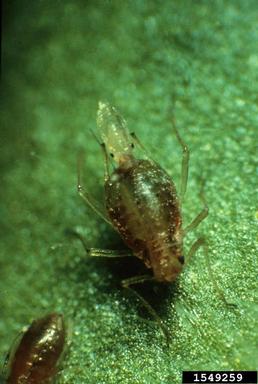
Figure 6. Wingless adult green peach aphid giving birth to a nymph. Figure credit: Jim Baker, North Carolina State University, Bugwood.org.
The green peach aphid (Fig. 6) is slender, dark green to yellow, and has no waxy bloom. Green peach aphids tend to cluster on the succulent young growth. Development can be rapid, often 10–12 days for a complete generation, and with over 20 annual generations reported in mild climates (Capinera 2005).
Green peach aphid feeds on hundreds of host plants in over 40 plant families. Vegetable hosts include artichoke, asparagus, bean, beets, broccoli, Brussels sprouts, cabbage, carrot, cauliflower, cantaloupe, celery, corn, cucumber, fennel, kale, kohlrabi, turnip, eggplant, lettuce, mustard, okra, parsley, parsnip, pea, pepper, potato, radish, spinach, squash, tomato, turnip, watercress, and watermelon. Field crops such as tobacco, sugar beet, and sunflower also are attacked. Many flower and ornamental plants are suitable for green peach aphid development. Stone fruit crops such as peach are sometimes damaged before the aphids leave for summer hosts. Crops differ in their susceptibility to green peach aphid, but actively growing plants, the youngest plant tissues, the undersides of leaves, or new sheltered growth most often harbor large aphid populations. Green peach aphid does not usually produce high volumes of honeydew. Blemishes to the plant tissue, usually in the form of yellow spots, may result from aphid feeding. Leaf distortions are not common except on the primary host.
Where suitable host plants cannot persist, the aphid overwinters in the egg stage on Prunus spp. The eggs are elliptical in shape, initially yellow or green, but soon turn black. In the spring, soon after the plant breaks dormancy and begins to grow, the eggs hatch and the nymphs feed on flowers, young foliage, and stems. Nymphs initially are greenish, but soon turn yellowish, resembling adults. Up to 8 generations may occur on Prunus in the spring, but as aphid densities increase winged forms are produced, which then disperse to summer hosts. Winged aphids have a black head and thorax, and a yellowish green abdomen with a large dark patch dorsally. Winged green peach colonize nearly all plants available, often depositing a few young and then taking flight again. This highly dispersive behavior contributes to their effectiveness as vectors of plant viruses. In cold climates, adults return to Prunus spp. in the autumn, where mating occurs and eggs are deposited. All generations except the autumn generation reproduce asexually.
The green peach aphid is considered to be the most important vector of plant viruses throughout the world. Nymphs and adults are equally capable of virus transmission. Both persistent viruses and non-persistent viruses, including cucumber mosaic and watermelon mosaic viruses, are effectively transmitted to cucurbits. Broadleaf weeds are suitable host plants for the green peach aphid and can serve as reservoirs for plant virus. Common weeds, such as field bindweed (Convolvulus arvensis), lambsquarters (Chenopodium album), and redroot pigweed (Amaranthus retroflexus), are important aphid hosts.
The Melon Aphid (Aphis gossypii)
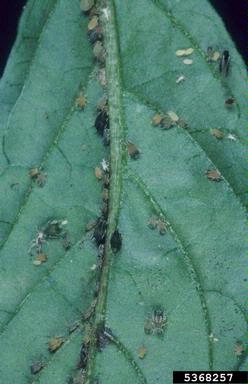
Figure 7. Melon aphid. Figure credit: Merle Shepard, Gerald R.Carner, and P.A.C Ooi, Insects and their Natural Enemies Associated with Vegetables and Soybean in Southeast Asia, Bugwood.org.
The melon aphid (Fig. 7) is also called the cotton aphid. Unlike most other aphids, this small aphid is able to tolerate hot weather, and hot, dry weather can cause populations to increase rapidly. The melon aphid develops in colonies and prefers the underside of leaves, but can also often be found evenly distributed along plant stems. Melon aphid can complete its development and reproduce in as little as a week, so numerous generations are possible when environmental conditions are suitable. The melon aphid is a vector for both non-persistently and persistently transmitted viruses. Fields infested with melon aphid should be disked or plowed under as soon as harvest is complete. Host weeds include milkweed, jimsonweed, pigweed, plantain, and field bindweed (Capinera, 2007).
Both winged and wingless forms are produced. The winged individuals are slender and are not as robust as the wingless form. The wingless adults can be yellow, green, black, or dark green and may have white patches on the abdomen. Colonies are often composed of individuals of several colors. Winged adults have black heads and antennae, dark red or black eyes, and an abdomen that is green to dark green with dark patches. The antennae are about one-half the length of the body. The cornicles are dark and always darker than the body.
The life cycle differs between north and south. In the north, female nymphs hatch from eggs on the primary, overwintering host in the spring. The primary hosts in northern locations include catalpa (Catalpa bignonioides), and rose of sharon (Hibiscus syriacus). When first deposited, the eggs are yellow, but rapidly become shiny black in color. In the south, females continue to produce offspring without mating as long as weather allows feeding and growth. Overwintering eggs are not commonly produced, but overwintering hosts include dock (Rumex crispus), henbit (Lamium amplexicaule), boneset (Eupatorium petaloiduem), and citrus (Citrus spp.).
The nymphs vary in color from tan to gray or green, and often are marked with dark head, thorax, and wing pads, and with the end of the abdomen dark green. The body is dull in color from wax secretions.
The melon aphid may feed, mature, and reproduce asexually on the primary host all summer, or they may produce winged females that disperse to secondary hosts and form new colonies. Under high density conditions, deterioration of the host plant, or upon the arrival of autumn, winged forms are produced. During periods stressful to the host plant, small yellow or white forms of the aphid can be produced. Late in the season, winged females seek primary hosts, where males and egg-laying females are produced. After mating, the females deposit eggs, which are the only overwintering form under cold conditions. Under warm conditions, a generation can be completed asexually in about seven days.
The Potato Aphid (Macrosiphum euphorbiae)
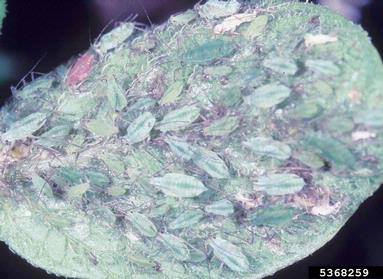
Figure 8. Potato aphid. Figure credit: Merle Shepard, Gerald R.Carner, and P.A.C Ooi, Insects and their Natural Enemies Associated with Vegetables and Soybean in Southeast Asia, Bugwood.org.
The potato aphid (Fig. 8) may be solid pink, mottled green and pink, or light green with a dark stripe. This aphid is much larger than the green peach aphid, and the adult has longer cornicles and very long legs. Potato aphids infest a wide range of host plants. This aphid can transmit cucurbit viruses. In addition to cucurbits, some important cultivated hosts include potato, tomato, eggplant, sunflower, pepper, pea, bean, apple, turnip, corn, sweet potato, asparagus, clover, and rose. Weeds such as ragweed, lambsquarters, jimsonweed, pigweed, shepherd's purse, and wild lettuce are also common food plants. In northern states, winter is passed in the egg stage on cultivated and wild rose bushes. The eggs hatch in the spring into wingless females which give birth to living young. In the fall, winged aphids fly to the winter hosts and produce females which mate and deposit overwintering eggs. In warm climates, eggs and males are not produced and female aphids feed and reproduce without mating year-round. Nymphs mature in two to three weeks. When overcrowding occurs or food becomes scarce, nymphs develop into winged adults and migrate to new host plants. Multiple generations are produced each year (Natwick et al., 2009).
The Black Bean Aphid (Aphis fabae)
The black bean aphid is dark olive green to sooty black with light-color legs and its membranous wings are held angled over the body like a tent when at rest. Not all individuals possess wings. This aphid is found mainly on the underside of leaves and only rarely on upper surfaces.
The eggs overwinter on the aphid's primary hosts, Eunomys spp., Viburnum spp., and Philadelphius spp. Winged forms migrate to crop hosts in the spring. On crop hosts, asexual reproduction and live births allow large populations to build up quickly. Winged and wingless forms are produced throughout the summer, allowing dispersal to new plants. In the autumn, aphids migrate to the primary hosts occurs. Sexual females are produced on the winter hosts, mating occurs and females lay eggs which overwinter (Natwick, 2010).
References and Citations
- Capinera, J. L. 2005. Green peach aphid [Online]. University of Florida Featured Creatures No. EENY-222. Available at: http://entnemdept.ufl.edu/creatures/veg/aphid/green_peach_aphid.htm (verified 18 May 2010).
- Capinera, J. L. 2007. Melon aphid [Online]. University of Florida Featured Creatures No. EENY-173. Available at: http://entomology.ifas.ufl.edu/creatures/veg/aphid/melon_aphid.htm (verified 18 May 2010).
- Natwick, E. T., J. J. Stapleton, and C. S. Stoddard. 2009. UC IPM: UC management guidelines for melon aphid on cucurbits [Online]. UC IPM pest management guidelines: Cucurbits, UC ANR Publication 3445, Insects and mites. UC Statewide IPM Program, University of California, Davis. Available at: http://www.ipm.ucdavis.edu/PMG/r116300711.html (verified 29 July 2011).
- Natwick, E. T. 2010. UC IPM: UC management guidelines for bean aphid on sugarbeet [Online]. UC IPM pest management guidelines: Sugar beets, UC ANR Publication 3469, Insects and Mites. UC Statewide IPM Program, University of California, Davis. Available at: http://www.ipm.ucdavis.edu/PMG/r735300311.html (verified 29 July 2011).
Additional Resources
- Greer, L. 2000. Greenhouse IPM: Sustainable aphid control [Online]. NCAT Sustainable Agriculture Project. Available at: https://attra.ncat.org/attra-pub/viewhtml.php?id=49 (verified 29 July 2011).
- Hollingsworth, C. S. 2009. Pacific northwest insect management handbook [Online]. Available at: http://insects.ippc.orst.edu/pnw/insects (verified 29 July 2011).
- Petzoldt, C. 2010. Cucurbits. Chapter 18, Part 1. [Online]. Integrated crop & pest management guidelines for commercial vegetable production. New York State IPM Program. Available at: http://www.nysaes.cornell.edu/recommends/18frameset.html (verified 29 July 2011).
- Kelley, W. T., and D. B. Langston, Jr. 2009. Commercial production and management of pumpkins and gourds. University of Georgia Cooperative Extension. Bulletin 1180. Available online at: http://www.caes.uga.edu/publications/pubDetail.cfm?pk_id=6279 (verified 29 July 2011).
- Nameth, S. T. Mosaic virus diseases of vine crops, HYG-3109-95. Ohio State University Extension Factsheet. Plant Pathology, The Ohio State University, Columbus, OH. Available online at: http://ohioline.osu.edu/hyg-fact/3000/3109.html (verified 29 July 2011).
- Randall P. ,and R. P. Griffin. 2009. Cucumber, squash, melon & other cucurbit insect pests. Clemson Cooperative Extension Bulletin No. HGIC 2207. Clemson University. Clemson, SC. Available online at: http://www.clemson.edu/extension/hgic/pests/plant_pests/veg_fruit/hgic2207.html (verified 29 July 2011).
- Seaman, A. (ed.) 2011. Production guide for organic cucumbers and squash [Online]. Available at: http://nysipm.cornell.edu/organic_guide/cucurbit.pdf (verified 29 July 2011).
- Shelton, A. M. Biological control: A guide to natural enemies in North America [Online]. Available at: http://www.nysaes.cornell.edu/ent/biocontrol/ (verified 29 July 2011).



